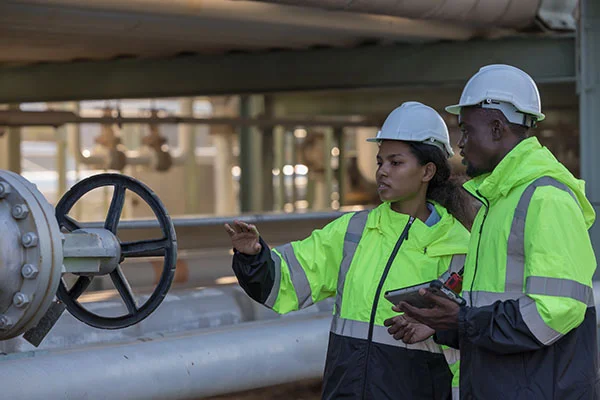
Los Angeles just made one of the boldest infrastructure bets in U.S. energy history. The Los Angeles Department of Water and Power (LADWP) board voted 3-0 to approve an $800 million conversion of two units at the Scattergood Generating Station in Playa Del Rey to run on green hydrogen. This isn't a pilot project or a research initiative. This is a full-scale commitment to replacing aging fossil fuel infrastructure with hydrogen-ready combined-cycle turbines capable of burning at least 30% green hydrogen from day one, with plans to eventually transition to 100% hydrogen as supply scales up.
The decision comes at a critical moment for grid reliability and decarbonization. Units 1 and 2 at Scattergood, dating back to the late 1950s, are legally required to shut down by the end of 2029. Rather than simply decommissioning them or replacing them with intermittent renewables, LADWP chose a path that preserves firm power while advancing L.A.'s goal of reaching 100% renewable energy by 2035.

"But you can't finish the job without green hydrogen or some other long-duration energy storage technology."
Paul Browning, Former Executive at Mitsubishi Heavy Industries and GE Vernova
Why Hydrogen Makes Sense for Grid Reliability
The Scattergood project isn't just about cutting emissions. It's about solving the reliability challenge that comes with heavy reliance on solar and wind. Los Angeles needs dependable, dispatchable power that can ramp up quickly to meet demand surges, especially in a region facing growing electricity needs from LAX electrification, wastewater treatment expansion, and general population growth.
Battery storage can handle short-duration fluctuations, but hydrogen offers something batteries can't match at this scale: long-duration energy storage and firm power generation. The National Renewable Energy Laboratory (NREL) backed LADWP's decision, concluding it's "difficult to identify economically viable and deployable alternatives to new combustion resources at the Scattergood location" given the tight 2029 deadline and the need to maintain grid stability.
>> RELATED: In Controversial Move, LADWP Says It Will Shift Its Largest Gas Power Plant to Hydrogen

The Technical Approach: Hydrogen-Ready Turbines
LADWP's strategy centers on installing new combined-cycle generation systems designed to operate on fuel blends from the start. The turbines will burn a mixture of natural gas and at least 30% hydrogen by volume when they come online in December 2029. As green hydrogen production ramps up across California and beyond, the plant can gradually increase the hydrogen percentage until it reaches 100%.
This phased approach addresses one of the biggest challenges in hydrogen deployment: supply. Green hydrogen, produced through electrolysis powered by renewable energy, currently faces production and cost constraints. By designing turbines that can run on blended fuel today while preparing for pure hydrogen tomorrow, LADWP creates immediate emissions reductions without waiting for the hydrogen economy to fully mature.

Moving Forward Without Federal Funding
The Scattergood project was originally expected to receive $100 million from ARCHES (Alliance for Renewable Clean Hydrogen Energy Systems), California's designated hydrogen hub. However, federal funding was cut before those dollars materialized. LADWP's decision to proceed anyway demonstrates the utility's confidence in both the technology and the business case.
David Hanson, Senior Assistant General Manager at LADWP, emphasized the project's importance: "This project is critical to LADWP's clean energy transition as it helps us preserve a key power system asset, meet our clean energy goals, and ensures reliability for our customers. The Scattergood modernization project is the No. 1 priority on the power system's 'Top 10' priority list."
The willingness to self-fund this massive infrastructure upgrade signals that hydrogen power isn't just a subsidy play. It's a strategic solution to a real grid reliability problem that utilities across the country are facing as they transition away from fossil fuels.

The Hydrogen Infrastructure Challenge
One critical aspect of the Scattergood project is that LADWP won't be producing its own hydrogen. Instead, the utility will purchase green hydrogen from suppliers, making this project dependent on the broader development of California's hydrogen production and delivery infrastructure. Jason Rondou, Assistant General Manager of Power Planning and Operations at LADWP, stated that upgrading the units now ensures they are "hydrogen-ready" when supply becomes available.
This approach actually accelerates the hydrogen economy by creating guaranteed demand. When utilities commit to purchasing hydrogen at scale, it gives producers, developers, and investors the confidence needed to build out production facilities and delivery infrastructure. Lorraine Paskett, Chief Operating Officer of First Public Hydrogen Authority, noted that the project "gives developers, investors, and communities confidence that Los Angeles is ready to lead on clean hydrogen at scale."
Timeline Comparison: Traditional vs. Hydrogen Approach
| Milestone | Battery-Only Approach | Hydrogen Approach |
|---|---|---|
| Units 1 & 2 Shutdown | Required by end of 2029 | Required by end of 2029 |
| Replacement Capacity | Intermittent, weather-dependent | Firm, dispatchable power |
| Initial Operation | Immediate, but limited duration | December 2029, 30% hydrogen blend |
| Long-Duration Storage | Limited to hours | Days to weeks possible |
| Full Decarbonization | Depends on grid mix | Achievable with 100% green H2 |
What This Means for the Hydrogen Industry
The Scattergood conversion represents more than just one utility's decarbonization strategy. It's a validation of hydrogen's role in the energy transition and a signal to the broader market that utilities are willing to make billion-dollar bets on hydrogen infrastructure.
For the hydrogen industry, this project creates several important outcomes:
1. Demand Signal: A guaranteed offtake commitment from a major California utility gives hydrogen producers the revenue certainty needed to secure financing for production facilities.
2. Technology Validation: The use of hydrogen-capable combined-cycle turbines at utility scale demonstrates that the technology is ready for commercial deployment, not just pilot testing.
3. Infrastructure Development: The project will require development of hydrogen delivery infrastructure to Scattergood, potentially including pipeline connections or on-site storage facilities that could serve other users in the region.
4. Workforce Development: Operating and maintaining hydrogen-fueled power plants requires specialized training, creating opportunities for workforce development in the clean energy sector.

"The Scattergood facility and some of the other coastal plants are part of the required infrastructure to enable L.A. 100 to become completely decarbonized."
Jack Brouwer, Director of the Clean Energy Institute at UC Irvine
Broader Context: U.S. Hydrogen Hub Development
The Scattergood project fits within California's broader hydrogen ambitions, particularly through ARCHES. Despite losing federal funding, California remains committed to developing a renewable hydrogen ecosystem. The state's continued investment in hydrogen infrastructure, combined with projects like Scattergood, positions California as a leader in the hydrogen economy.
This mirrors developments across the country where regional hydrogen hubs are taking shape. From the Mid-Atlantic Clean Hydrogen Hub to the Appalachian Regional Clean Hydrogen Hub, utilities and industrial users are increasingly viewing hydrogen as essential to achieving deep decarbonization while maintaining energy reliability.
The Path Forward
LADWP's Scattergood conversion demonstrates that the transition to clean energy doesn't require choosing between reliability and sustainability. By investing in hydrogen-ready infrastructure today, Los Angeles is building the foundation for a fully decarbonized grid tomorrow.
The project also sends a message to other utilities facing similar challenges: hydrogen isn't just a theoretical solution. It's a practical, commercially viable option for replacing fossil fuel baseload generation with clean, firm power. As Commissioner Nurit Katz of LADWP acknowledged, "This project shows how complex and challenging this transition to clean energy is," but it also shows that utilities are ready to tackle that complexity head-on.
Setting the Standard for Other Cities
As cities across the United States grapple with ambitious decarbonization goals, the Scattergood project offers a roadmap. It shows that achieving 100% clean energy doesn't mean sacrificing grid reliability or making compromises on energy security. Instead, it requires strategic investments in technologies like hydrogen that can provide the firm, dispatchable power that renewables plus batteries alone cannot deliver at scale.
The combination of carbon capture and storage technologies developing alongside green hydrogen production creates a comprehensive toolkit for decarbonization. LADWP's decision to move forward with Scattergood, even without federal support, proves that the economics of clean firm power are becoming compelling enough to stand on their own.
Other major cities watching this project will see that hydrogen isn't just about environmental goals. It's about maintaining the reliable, affordable power that modern cities need while meeting aggressive climate targets. That combination makes Scattergood one of the most important energy infrastructure projects in the United States today.
Subscribe to the newsletter
Daily decarbonization data and news delivered to your inbox
Follow the money flow of climate, technology, and energy investments to uncover new opportunities and jobs.
Latest issues
-
The Deal Structure Everyone's About to Copy
Inside This Issue 💼 The Deal Structure Everyone's About to Copy 📈 Exxonmobil Raises Its 2030 Plan – Transformation Delivering Higher Earnings, Stronger Cash Flow, and Greater Returns ⚡ Nextera Wor...
-
Inside XCF Global's $300M Bet to Double U.S. SAF Output
Inside This Issue ✈️ Inside XCF Global's $300M Bet to Double U.S. SAF Output ⚙️ Capsol Technologies Signs MoU with US Utility to Deploy CapsolGT® for Low-carbon Gas Power Generation 🏭 Babcock &...
-
64 Carbon Projects Were Stuck. Texas Just Unlocked Them
Inside This Issue 🛢️ 64 Carbon Projects Were Stuck. Texas Just Unlocked Them ⚙️ In Ohio, Hydrogen Industry Presses on Despite Federal Uncertainty 🧲 Agami Zero Breaks Through With Magnetic Hydrogen...
Company Announcements
-
Clean Planet Technologies (CPTech), part of the Clean Planet Group, has announced that its core pyrolysis-oil upgrading process has now been formally patented in both the United States and Saudi Ar...
-
(December 12, 2025 - Oslo, Norway) Nel ASA (Nel, OSE: NEL) is pleased to announce that following a seven-year development program, and now a successful start-up and production of clean hydrogen on ...
-
Hydrogen Technology Venture Launches in Bowling Green
BOWLING GREEN, Ky. — A new tech company is coming to Bowling Green, bringing dozens of jobs to Warren County. What You Need To Know UFS ARK will be a joint venture of United Fiber Sensing and OgM...
-
HyOrc Positions Green Methanol as the Economic Solution to Shipping’s Decarbonization Challenge
HOUSTON, Dec. 12, 2025 (GLOBE NEWSWIRE) -- HyOrc Corporation (OTCID: HYOR), a fully SEC-reporting clean-energy company focused on decarbonizing heavy industry, today commented on the growing global...